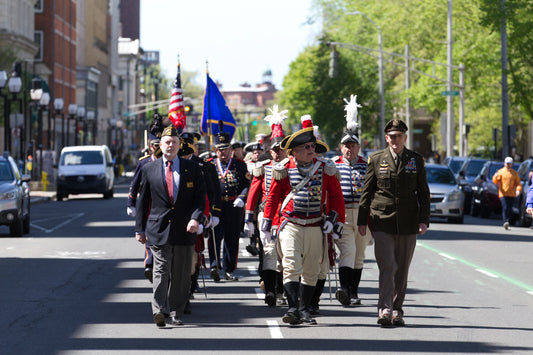Central Station Fire Headquarters has been called a “fortress,” a “visual surprise,” a “gateway” to Wooster Square—and a few choice, less flattering words. The New Haven Preservation Trust will call Central Station a “landmark” of “outstanding and enduring architectural and historical significance” when the firehouse is awarded one of the NHPT’s annual Preservation Awards tomorrow evening, along with two other projects of the same vintage. Like the NHPT itself, all three are celebrating their 60th birthdays this year.
Regardless of what you call the 1961 fire station, many New Haveners know the commanding concrete structure designed by architect Peter Millard, which stands prominently at the downtown end of Grand Avenue. Retired battalion chief Edward Flynn, Jr., who first worked at Central Station in 1962, is among those who know it best. On a top-to-bottom tour, Flynn shares some of the building’s features, quirks and stories.
sponsored by
“I was in awe of the size of it ’cause we were all in the smaller fire houses,” he recalls of his first days as a relief firefighter called in to the new building. We’re standing on the second floor, designed as a wide-open recreation room for firefighters but partitioned since the 1980s into smaller offices and cubicles to accommodate a growing work force. The other half of the second floor still houses the firefighters’ barracks, kitchen and rec area.
Offices take up the third floor as well, including a balcony that was enclosed to expand the space around 1971, one of the rare external modifications made over six decades. Here, Flynn points out the location of his old cubicle, with a view of the rear parking lot and apartments located on the site of the neighborhood’s original firehouse, a two-story brick structure with four bays that faced Olive Street. Flynn, who acts as the department’s historian and record-keeper, is a font of firehouse stories. For example, the first time they repainted the trucks from red to white just after World War II, he tells us, they came out pink.
Chief John A. Alston, Jr.’s office is also on the third floor, with access to the roof outside his window. Here Alston, who came to New Haven from Jersey City in 2016, learned his way around the city, listening to calls coming in and mentally pegging addresses and cross streets as trucks went out. If he saw heavy smoke, he’d go, too. It wasn’t necessary to get a rooftop view; today’s computer technology tells him “where every truck is at all times, even how long it will take them to get to any particular point in the city.” But the new chief wanted to understand the city, not just the data.
Alston’s rooftop view is partially obscured to the west, where the tallest of Central Station’s four towers rises another couple of stories. This tower adds grandeur and variety to the structure, says architect Peg Chambers of the NHPT. “Sometimes when I pass by this building in a car, it’s almost as though these towers are pistons,” she remarks of the shifting perspective. But the tallest tower was also built to serve a practical purpose. If you enter it from the ground floor and look up at a triangle of daylight high above, you’ll see old hooks and a pulley system once used to hang fire hoses to dry.
The station’s literal bells and whistles are on the ground level, where two massive fire engines, vehicles for the deputy and assistant chiefs, a water rescue craft and the Fire Investigative Unit vehicle are parked. Flynn notes the city stopped calling it the “arson truck” because people would assume arson was suspected whenever it appeared on the scene. An antique truck that firefighters restored with funds they raised themselves is stored under a protective cover. It was brought out for the first time for the funeral of firefighter Ricardo Torres, Jr., who lost his life while fighting a house fire on May 12.
Central Station takes about a dozen calls every day and another dozen overnight. During our visit, a buzzer goes off, followed by an alarm and an announcement, and the Engine 4 crew swings into place. The station’s six original brass fire poles are still in use. One of the six glass bay doors opens, and the engine pulls out, siren wailing.
Outside, the building’s concrete surface is ornamented with vertical notches of varying lengths and positions that span the seams between its concrete segments, which were poured on-site. These grooves serve both function and form. Architect Millard “saw an opportunity for patterning in the fact that the formwork has to have places where it grips,” Chambers explains. The ornamental grooves were positioned to hint at the location of the stairs, landings and floors inside. Grooves are repeated on the interior in some places, what Chambers calls “sort of a trick” to subtly remind you of the outside.
Central Station has its problems, including deferred maintenance that needs attention. And, as mentioned, not everyone loves its look. “There’s always resistance to new form in architecture or any public space, you know?” Chambers says. “People are uncomfortable with the edgy, but honestly, I think if you were to take a sampling of the community, you’d find they kind of grew to like this.”
Two other 1961 builds are being honored by the NHPT this year: Newhall Gardens on Daisy Street and Harry A. Conte West Hills Magnet School on Chapel Street. The Preservation Awards, which were discontinued about 20 years ago and revived in 2014, help people notice buildings they might otherwise miss because they’re so familiar, says architect and awards chair Duo Dickinson. He calls New Haven “an amazing quilt of different styles, humans, decades, cultures side by side,” which is reflected in its buildings.
Those juxtapositions are certainly clear at the intersection of Olive and Grand, where Central Station looms among 19th-century brick. But Alston balks at the “fortress” metaphor. “I think of it as a place of refuge as opposed to being fortified,” he says. “It belongs to everyone in the city and all of our visitors, and… it is a place where they can come in and get whatever they need. And if we don’t have it, we’re going to make sure they get it.”
Central Station Fire Headquarters
952 Grand Ave, New Haven (map)
www.newhavenct.gov/…
Written by Kathy Leonard Czepiel. Image 1 photographed by Dan Mims. Image 2 photographed by Kathy Leonard Czepiel. Image 3 provided courtesy of the New Haven Preservation Trust.








